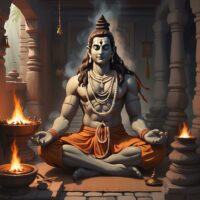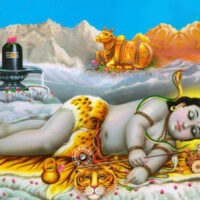Grihapati : The Household Guardian
Listen
At a glance
| Description | |
|---|---|
| Origin | Indian Mythology |
| Classification | Demigods |
| Family Members | Sage Visvanara (Father), Shuchismati (Mother) |
| Region | Indian |
| Associated With | Household, Protection |
Grihapati
Introduction
In the extensive realm of Hindu mythology, Lord Shiva is revered not only as the ascetic yogi and destroyer of evil but also as a divine presence who assumes various forms to guide humanity. One of his lesser-known but deeply symbolic manifestations is Grihapati, an avatar associated with household life, duty, and devotion. Unlike the fierce forms of Shiva such as Bhairava or the cosmic dancer Nataraja, Grihapati highlights the sanctity of domestic responsibilities, showing that spiritual growth can flourish within the structure of family life. This avatar emphasizes balance—between asceticism and worldly duties—presenting the home not just as a physical shelter but as a sacred space where dharma, order, and spiritual progress unfold. The story of Grihapati blends mythology with cultural ideals, underscoring the importance of devotion, resilience, and divine blessings within the fabric of ordinary existence.
Physical Traits
Descriptions of Grihapati do not focus on distinct physical features in the way that other deities or avatars are depicted. Instead, he is portrayed more through his demeanor and symbolic qualities. Artistic imagination often visualizes him as a calm and composed figure, embodying the grace of Shiva yet carrying the simplicity of a devout householder. He is imagined wearing sacred marks of ash, a yajnopavita (sacred thread), and carrying items like a water pot and prayer beads—objects associated with ritual discipline and spiritual practice. The absence of fierce or wrathful characteristics sets him apart from Shiva’s destructive aspects. Instead, Grihapati radiates tranquility, embodying wisdom, humility, and unwavering devotion. His form represents the serene power of inner strength and faith, offering an image of the perfect householder who combines worldly responsibilities with spiritual commitment.
Family
The mythological origins of Grihapati root him in a story of deep devotion and divine blessing. He was born as the son of Sage Visvanara and his wife Shuchismati, a couple who lived by the Narmada River and longed for a child. Their fervent prayers moved Lord Shiva, who promised to be born as their son. When their child was born, Lord Brahma himself named him Grihapati. The name symbolized not only his human role as the head of a household but also his divine mission of elevating domestic life into a spiritual pursuit.
As a concept, the role of Grihapati in ancient Indian tradition extended beyond this myth. Within households, the Grihapati was the patriarch, responsible for managing the family, conducting fire rituals, and ensuring the continuity of dharma. After his death, the responsibility typically passed to the eldest son, reflecting the continuity of household duty. In this way, Grihapati served as both a mythological figure and an archetype for real-life family leaders who maintained order and guided their households with integrity.
Other names
The name Grihapati itself has layered meanings, and depending on context, he is referred to by other titles that shed light on his significance. In Vedic literature, the word commonly refers to a householder, the central figure in the second stage of life, who is married and actively engaged in maintaining a family. In another interpretation, Grihapati appears as an epithet of Agni, the fire god, emphasizing the link between household duties and sacrificial rituals.
In Puranic texts, the identity of Grihapati extends further. He came to be known as Agneeshwara, the lord of fire, after his intense devotion led him to worship a lingam in Kashi that became famous as the Agnishwar Lingam. He is also associated with the title “lord of all directions,” a divine role granted to him by Shiva as a reward for his steadfast faith. Through these various names and associations, Grihapati embodies different facets of household life, ritual sacrifice, and divine guardianship.
Powers and Abilities
The powers of Grihapati do not lie in feats of destruction or conquest but in the strength of devotion, knowledge, and divine grace. From a young age, he demonstrated exceptional mastery over the Vedas and Shastras, absorbing sacred knowledge with remarkable ease. This deep understanding established him not only as a son of great promise but also as a spiritual guide.
One of the pivotal episodes in his story is his penance in Kashi, where he sought protection from a foretold death by fire. His devotion was so intense that even when threatened by Indra with the mighty Vajra weapon, he remained unmoved in meditation. Lord Shiva appeared to protect him, granting him immunity from death and the destructive power of fire. By this blessing, Grihapati became the regulator of all directions and a divine guardian who could control the force of flames.
These gifts symbolize more than supernatural abilities; they represent resilience, inner discipline, and the ability to overcome destiny through faith. Grihapati’s life illustrates how spiritual strength can triumph over external threats, and how devotion can transform vulnerability into divine protection.
Modern Day Influence
Though Grihapati is not worshipped as widely as other avatars of Shiva, his influence is deeply embedded in cultural and spiritual practices. The role of the householder remains central in Hindu thought, and the ideals associated with Grihapati continue to resonate in modern life. For example, rituals like Griha Pravesh (housewarming) often invoke Shiva’s blessings, reflecting the belief that domestic spaces are sacred. Fire rituals performed in households, echoing the connection with Agni, also embody the discipline and devotion that Grihapati represents.
In the symbolic sense, Grihapati serves as a reminder that spirituality is not confined to forests and monasteries but can thrive within the family home. The idea that one can achieve spiritual progress while fulfilling household responsibilities continues to inspire individuals today. Grihapati’s example encourages a balanced lifestyle, where devotion, ethical conduct, and familial responsibility go hand in hand.
His story also has relevance in contemporary discourse on leadership and responsibility. The Grihapati of a family is seen as a guide who provides stability, empathy, and justice—qualities essential not just in households but in larger social structures. In this way, Grihapati’s values extend into discussions about leadership in community and professional life, where compassion and duty must align with knowledge and discipline.
Moreover, Grihapati’s myth highlights themes of psychological resilience and spiritual integration, making him a figure of relevance even in modern spiritual counseling and personal development. By embodying the fusion of faith, scholarship, and domestic responsibility, Grihapati remains a model of how ordinary life can be lived in extraordinary ways.
Related Images
Source
Mythology Mantra. (2023, August 31). Avatars: Exploring the Profound Significance of Lord Shiva’s 19 Avatars. Retrieved from https://mythologymantra.com/lord-shiva-19-avatars-in-hindu-mythology/
Hindu Temple Talk. (2023, August 8). 28 Avatars of Lord Shiva. Retrieved from https://hindutempletalk.org/2023/08/08/28-avatars-of-lord-shiva/
Acharya Ganesh. (2024, November 22). The Divine Forms: Understanding the 19 Avatars of Lord Shiva. Retrieved from https://acharyaganesh.com/gods-avatars/lord-shiva-avatars
A. A. (1990). The Earliest Inscription of Rama-Worship. Journal of the Indian Society of Oriental Art, 44148342.
Chakrabarti, S. (1992). THE CHANGING CONCEPT OF’GRIHAPATI’. Proceedings of the Indian History Congress, 44142773.
Jain, S. C. (1993). Therapeutic wisdom in Indian mythology. Indian Journal of Psychiatry, 35(2), 91.
Lal, P. (1980). State formation in early India. The Indian Economic & Social History Review, 17(1), 1–10.
Grihapati, Gṛhapati, Griha-pati: 19 definitions. (2024). https://www.wisdomlib.org/definition/grihapati
Grihapati Avatar of Lord Shiva – Devotional India. (n.d.). https://devotionalindia.com/grihapati-avatar-of-lord-shiva/
Frequently Asked Questions
What is lorem Ipsum?
I am text block. Click edit button to change this text. Lorem ipsum dolor sit amet, consectetur adipiscing elit. Ut elit tellus, luctus nec ullamcorper mattis, pulvinar dapibus leo.
What is lorem Ipsum?
I am text block. Click edit button to change this text. Lorem ipsum dolor sit amet, consectetur adipiscing elit. Ut elit tellus, luctus nec ullamcorper mattis, pulvinar dapibus leo.
What is lorem Ipsum?
I am text block. Click edit button to change this text. Lorem ipsum dolor sit amet, consectetur adipiscing elit. Ut elit tellus, luctus nec ullamcorper mattis, pulvinar dapibus leo.
What is lorem Ipsum?
I am text block. Click edit button to change this text. Lorem ipsum dolor sit amet, consectetur adipiscing elit. Ut elit tellus, luctus nec ullamcorper mattis, pulvinar dapibus leo.
What is lorem Ipsum?
I am text block. Click edit button to change this text. Lorem ipsum dolor sit amet, consectetur adipiscing elit. Ut elit tellus, luctus nec ullamcorper mattis, pulvinar dapibus leo.








